
Lake Johnston Project
The Lake Johnston Project is located ~300km from Kalgoorlie in the Southern Goldfields region of Western Australia. It covers +50 km strike of the Lake Johnston Greenstone Belt, which consolidates the southern region for the first time.
The Location
Located between two prolific WA greenstone belts, the Lake Johnston Greenstone Belt is geologically similar to the prolific gold, lithium and nickel producing Norseman-Wiluna and Southern Cross greenstone belts. Historically overlooked and under-explored – Lake Johnston was never the main project focus for the “nickel majors” that held the ground historically. TG Metals has the most significant land package ever held by one company in the history of exploration within the Lake Johnston Greenstone Belt.
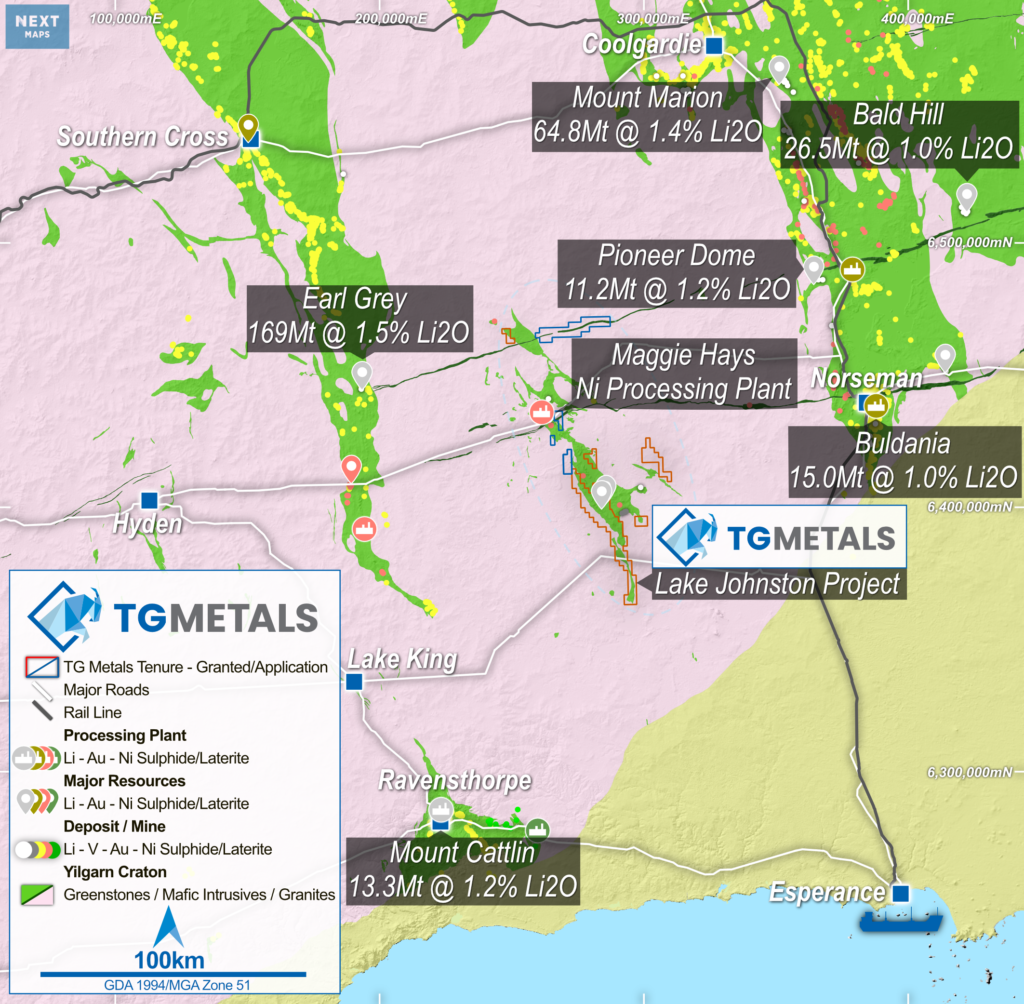
Burmeister Lithium Deposit
The Lake Johnston Greenstone Belt hosts defined Lithium-caesium-tantalum (LCT) pegmatites – a source of about one-fourth of the world’s lithium production and most of the tantalum production. TG Metals has discovered the Burmeister Lithium Deposit, a series of stacked shallow dipping spodumene bearing pegmatites (refer to figure below). The pegmatites are “blind” under cover with no outcrop and were discovered by drilling beneath prominent lithium soil anomalies. TG Metals completed a series of Reverse Circulation (RC) and Diamond Drilling (DD) programs in late 2023 and early 2024 to be able to calculate an Exploration Target.
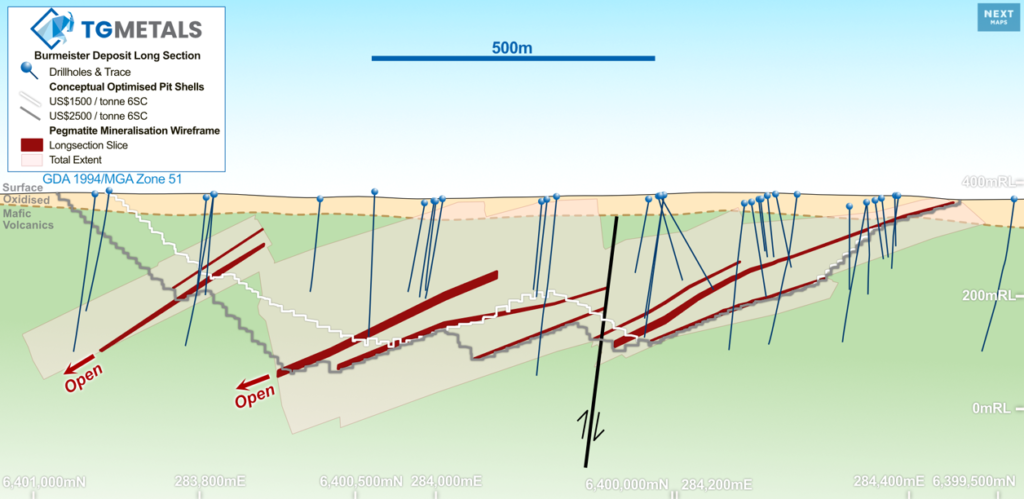
An Exploration Target Statement was announced on the 1 May 2024 (ASX Release) of:
| Tonnes Range Low | Tonnes Range High | Li20 Range Low (%) | Li2O Range High (%) |
| 15.6 million | 20.1 million | 0.97 | 1.19 |
The Exploration Target quantity and grade is conceptual in nature and is based on the TG Metals resource definition drilling undertaken since discovery in October 2023. The current drill hole density (spacing between holes) at Burmeister is not considered sufficient to determine a Mineral Resource and the next program of drilling will infill to achieve a 100m x 100m spacing that TG Metals believes based on the nature of the pegmatite intrusive will be able to achieve an inferred resource.
The drilling defining the Burmeister pegmatites has been modelled within grade envelopes and aggregated to determine the total Exploration Target ranges in the table above. The cutoff grade of 0.4% Li2O was determined as the lowest grade assayed within all pegmatite intercepts, including RC drilling intervals, which crossed pegmatite-basalt boundaries. This captures all the lithium mineralisation within the pegmatite hosts which is predominantly spodumene. The size of the Target and the results of “Conceptual Pit Optimisations” (Figure below) provide support for the Company’s strategy to develop a stand-alone lithium mining and processing operation at Lake Johnston. The deposit remains open at depth and at the limit of the conceptual pit shells, 290m depth for the USD$1500 shell and 340m depth for the USD$2500 shell, offering further opportunities at depth for deposit extensions. Further studies including metallurgical testwork and mining assessments are required to confirm the validity and economics of a custom processing Plant suitable for the Burmeister ore.
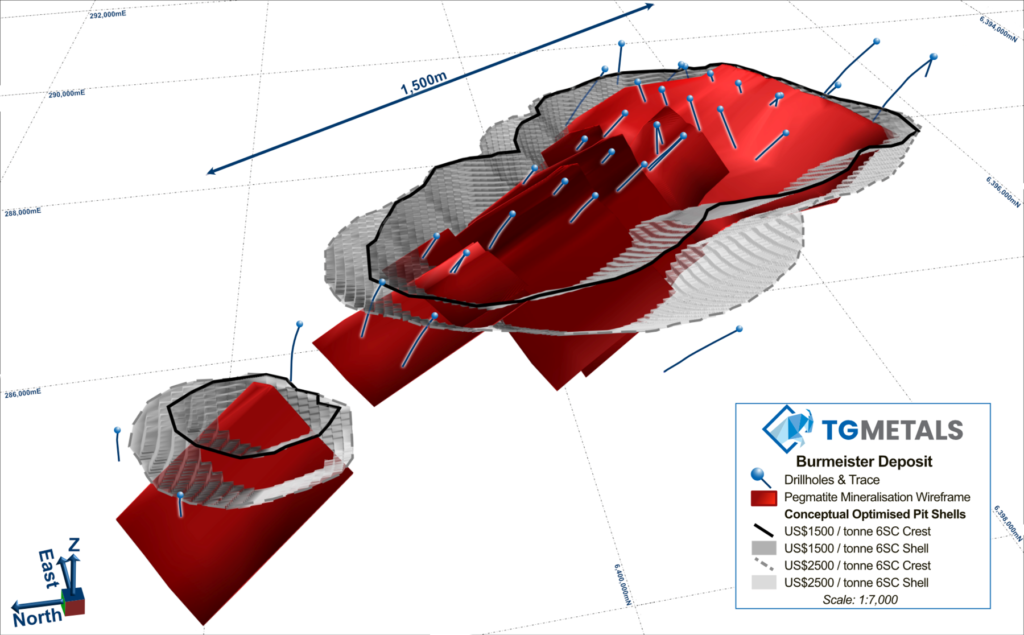
Jaegermeister Lithium Prospect
The prospect has significant untested potential for lithium mineralisation. Soil geochemical sampling over the region northeast of Burmiester has defined several high tenor lithium anomalies (refer to map below) – significantly larger than the Burmeister Lithium Deposit.
A similar exploration methodology used to define Burmeister Lithium Deposit has been employed over this region previously not explored for lithium. In addition to surface sampling, a recent seismic survey completed over this region will be able to guide drilling by mapping the location of subsurface pegmatite intrusive bodies.
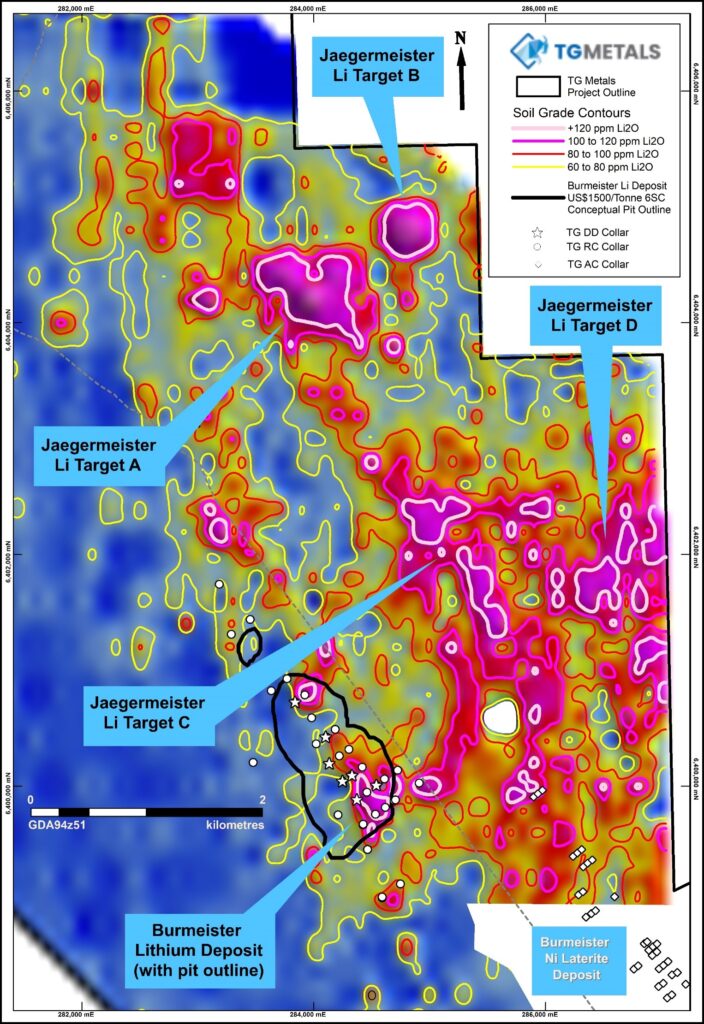
Bremer Range Ni Co Laterite Deposits
The majority of the historical drilling is shallow – testing only the oxide material. Multiple drill results of +1% nickel and cobalt up to 6,900 ppm defines large nickel-cobalt oxide (surficial/lateritic) deposits. Any “Exploration Target” for nickel-cobalt oxide deposits stated by past operators is not compliant with the JORC Code.
TG Metals completed a desktop study on past drilling focusing on the potential of nickel laterite deposits at Bremer Range and were able to define an Exploration Target based on historical drilling data (ASX Release on the 10 November 2022) of:
| Exploration Target Cutoff Grades | Tonnes Range Low | Tonnes Range High | Ni Range (Low %) | Ni Range (High %) | Co Range (Low %) | Co Range (High %) |
| 0.3% Ni | 28 million | 32 million | 0.41 | 0.47 | 0.029 | 0.034 |
| 0.5% Ni | 7 million | 8 million | 0.55 | 0.65 | 0.045 | 0.053 |
The potential quantity and grade of the Exploration Target is conceptual in nature. It is based on historical drilling data which is of variable quality and deficient in some analysis for deleterious element and compositing of samples (up to 4m) is not conducive to determining a Mineral Resource of sufficient accuracy. Past drilling did however, define 5 zones of nickel laterite mineralisation. These zones were modelled within defined grade enveloped and aggregated to determine the total Exploration Target ranges in the table above.
Mineralisation envelopes were interpreted in section from drill data. A nominal 0.2-0.3% Ni edge lower cut off was initially developed and adjusted as required to capture and delineate the majority of significant and related Copper (Cu), Cobalt (Co), Chrome (Cr) and Zinc (Zn) mineralisation. The development of wire-frames were tightly controlled and typically not extended (extrapolated) beyond one average section spacing from the last drillhole ‘point of observation’. The 5 main mineralisation areas defined and modelled are outlined in the figure below (Area 2 and Area 4 are not labelled however defined by the yellow outline). In addition, 3 typical or example sections to illustrate the nature of the Bremer Range Ni-Co laterite mineralisation.
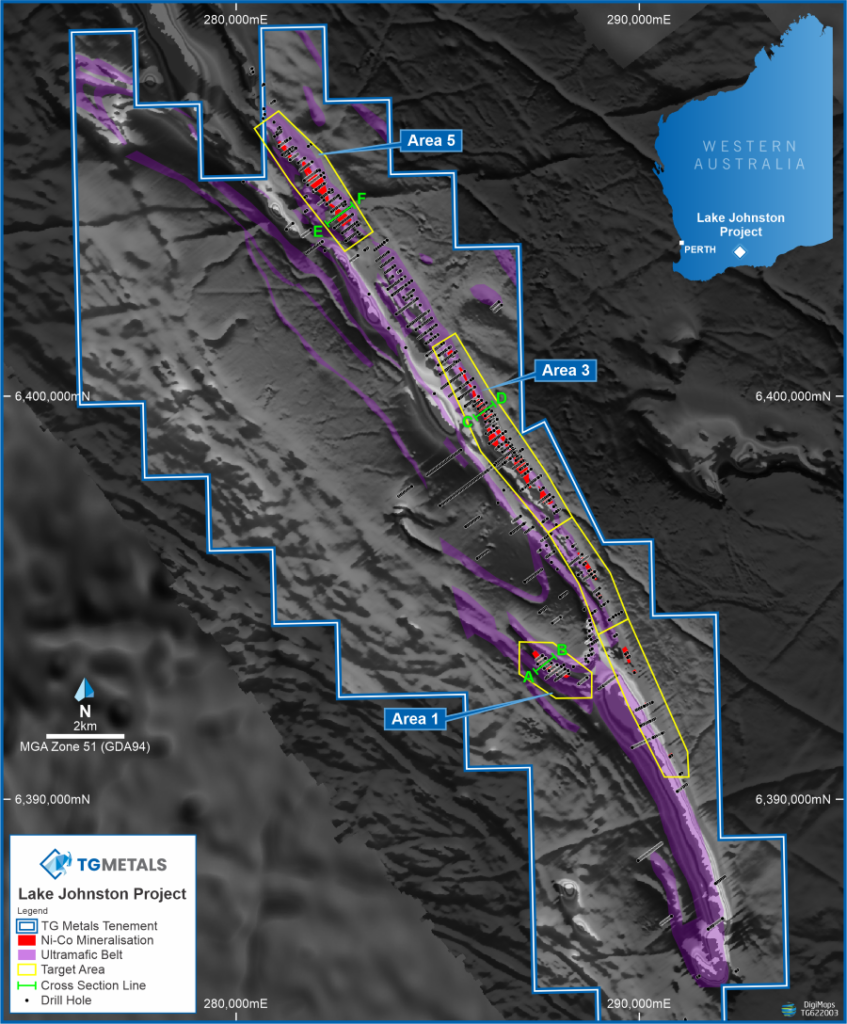
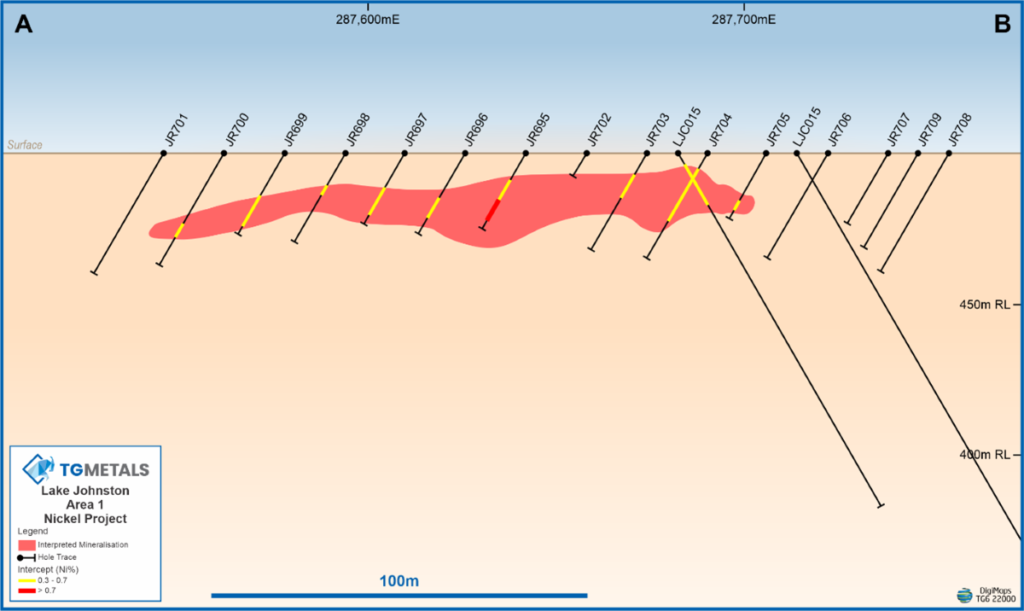

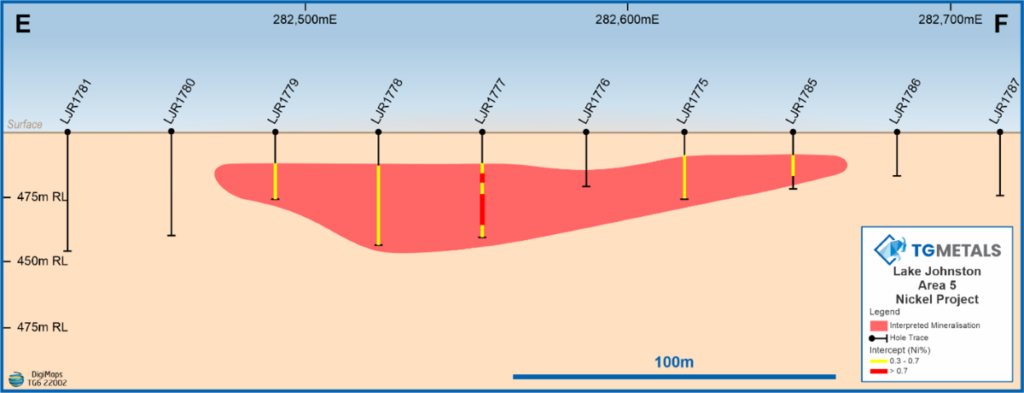
Exploration Strategy
Despite a long history of exploration in the Lake Johnston Belt, surficial cover and deep weathering have made discovery a challenge. TG Metals is overcoming these challenges through modern geophysical and geochemical techniques. Already the new geochemistry via lithium soil sampling has been successful in discovering blind lithium pegmatites at the Burmeister discovery. In addition, TG Metals is investigating seismic as a means to depict subsurface geological boundaries. LIDAR (Light Detection and Ranging) has also been effective in defining topographical features which show previously unseen subsurface structures. TG Metals has a staged approach to mineral exploration which focusses in on mineral occurrences and deploys drilling in a targeted cost-effective manner.
TG Metals intends to continue it’s staged, targeted approach, employing modern techniques to capitalise on mineral targets which have not been being fully tested or completely missed in past exploration including Tay, Pagrus Hill, Wellstead Rock and Taylor Rocks lithium prospects.
